1 Why Should Youth Services Librarians—Public & School— Encourage Writing?
Origin of the Writing Boxes
In 1993, I was newly matriculated into a Masters of Library Science Program. I was employed as a Librarian Trainee II with the Brooklyn Public Library, posted to the Park Slope Branch, a mixed-class neighborhood. And I had a dark secret: I couldn’t write. I was nauseated by the thought of college essays and research papers. How was I going to get through graduate school? I had barely made it through my undergrad classes, creatively providing and producing alternative assessment products (anything except research papers) to survive my writing anxiety.
Luck, miracle, or fate brought Dr. Robert Maloy and Sharon Edwards, authors of Kids Have All the Write Stuff[1], to my small branch library. They were on an author tour, and the publisher offered to have them visit for a parent education program.
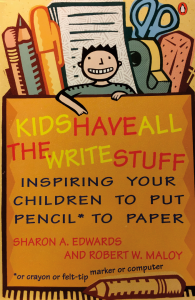
Dr. Maloy, a University of Massachusetts professor, and Ms. Edwards, an elementary school teacher, had created a writing program designed to inspire young children to write on their own. Dr. Maloy’s research on writing anxiety in students of every level, from elementary to college, had brought him to Ms. Edward’s second-grade class. He came to the conclusion that writing anxiety begins as children start learning to write in the classroom setting. The pressures of forming letters on the page, acquiring fine motor skills, developing literacy skills, and learning to spell all lead to rampant perfectionism and paralysis. The consequence? A lifelong inability to put words on a page to communicate ideas.
To encourage writing as an enjoyable activity they provided Writing Boxes, one for each child in Ms. Edward’s class. These boxes were plastic containers with writing materials (pencils, pens, markers, crayons, glue, paper, etc.). Children brought the Writing Boxes home with no restrictions; they could write what they wanted, when they wanted, and how they wanted. The experiment succeeded beyond the authors’ wildest hopes. There was an explosion of writing by the students, who created signs, poems, recipes, maps, cartoons, letters, journals, and handmade books. Reading scores improved. Edwards and Maloy determined that the success of the program lay simply in its having provided the children with writing materials, opportunities to write, and a nonjudgmental writing space.
That evening, in my library, Ms. Edwards and Dr. Maloy spoke in practical terms about literacy, child development, and the reading/writing connection. They encouraged parents to inspire reading and writing by simply providing materials, space, and non-judgmental reflections.[2]
As I watched them describe how to put together Writing Boxes for school and home, I wondered if we could do this Writing Box thing as a public library program. I also had my first graduate school paper due in two weeks in my Services to Children class. Could I write about Writing Boxes for this assignment? I was curious to see if I could give myself permission to “write to please myself,” to “take off the editor’s hat” and be non-judgmental while I was writing.
I read and reread their book, with the goal of creating a safe and creative space for writing in my public library. After persuading Ann Kalkhoff, the Branch Librarian, to allow an experiment in the children’s room, I created Writing Boxes filled with supplies, raided the recycling box next to the copier/printer for paper, and set up Writing Box workshops for the upcoming summer reading program.
My background in children’s literature and experience working in children’s museums informed my understanding of how to structure a weekly workshop around writing. That summer, I experimented with cartooning, secret codes, map making, jokes, picture book making, recipes, and the retelling of fairy tales, and made two Writing Boxes available for use in the library (they were labeled as Reference Materials) in the afternoons.
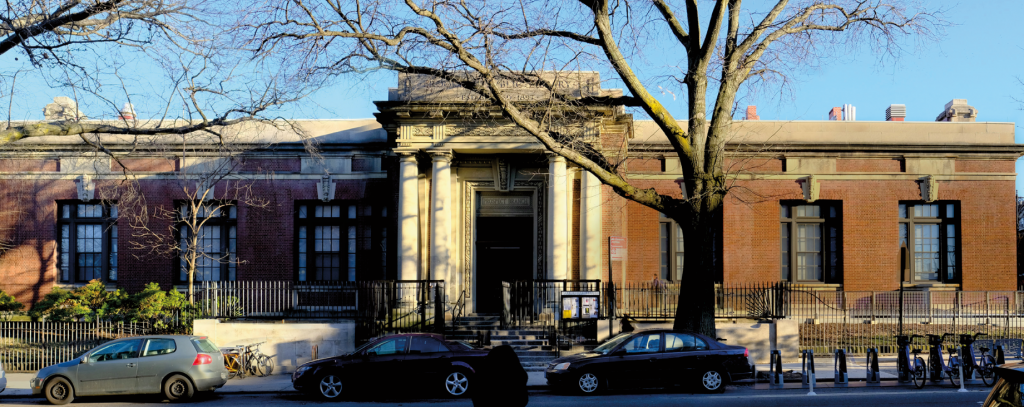
Success
The weekly workshops were successful in enticing 10–20 children, ages 5–12, to drop in on Wednesdays mornings from 10:00 to 11:30 as part of our summer reading program. We had the Writing Boxes on the tables, but supplemented their contents with additional supplies. The Writing Boxes were then available in the children’s room to sign out for use in the library. With one designed for preschool children and one for those in elementary school, each contained developmentally appropriate supplies such as rounded safety scissors in the box intended for younger writers.
We discovered that parents and children enjoyed writing together. And while we initially feared that supplies might disappear or be misused, this never happened.
A surprising opportunity to continue the program came when the New York City Mayor delayed school openings for 11 days while workers performed asbestos abatement on more than 100 schools, including those closest to our branch.[3] Parents scrambling for childcare turned to the public libraries for a safe space for their children while they were at work. During the next week, we consistently had 50–60 children who were happily occupied reading and writing. This experience confirmed that the workshops and materials were suitable for a diversity of ages, and could be scaled up or down as needed.
Measured by engaged writers and returning participants, the success of the Writing Box program inspired us to recruit other branches for the next summer, and the program office of the Brooklyn Public Library generously provided materials to all of them. In its third year, 63 branches engaged in some form of the program. A year later, I presented a workshop at the New York State Library Association Conference, encouraging librarians to include Writing Boxes as part of the New York State Summer Reading Program.
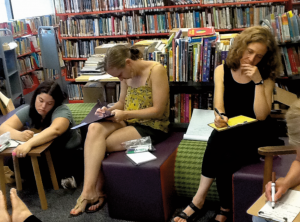
Getting started
Over the last 20 years, wherever I’ve been a librarian, there have been Writing Boxes. I’ve conducted Writing Box workshops with librarians and teachers in systemwide training for the New York City Department of Education and for Maricopa County Libraries in Arizona, as well as at conferences like those of the New York Library Association, the Minnesota Library Association, the American Library Association, and the Association for Library Service to Children (ALSC). The program works.
The Why
No one questions the role of youth services librarians in the promotion of literacy. We develop collections for this purpose, selecting the best of the best so as to surround readers with high-quality materials. We partner with teachers to support their curricula with high-interest, age-relevant materials, and provide summer reading programs to prevent the loss of skills.[4] Many public libraries now provide summer learning opportunities beyond reading, including STEM programs (Science Technology Engineering Math) and Maker Spaces, which encourage creativity.[5] Youth services librarians have responded to the call to provide enrichment programs to support summer learning, working to stem what has been termed the “summer slide,” and to prevent a loss of reading and math skills in elementary aged students.
One of the most significant initiatives of the ALSC and the Public Library Association (PLA) divisions of the American Library Association, which serves children ages 0–18, focuses on literacy. The Every Child Ready to Read® @ your library® (ECRR) program (everychildreadytoread.org) incorporates simple, research-based practices, to help parents and caregivers develop early literacy skills in children. By teaching the primary adults in a child’s life about the importance of early literacy and how to nurture pre reading skills at home, ECRR multiplies library efforts many times over. We would be hard pressed to find a person who doesn’t believe that part of a school or public libraries’ mission is to support reading fluency or literacy in citizens of all ages.
What isn’t so obvious, however, is the reading/writing connection. Just as children’s librarians encourage reading aloud and the sharing of books, it is essential that we share the joy of writing and communicate the links between writing and literacy. We’re not there yet; more than 25 years after Edwards and Maloy’s experiences in the classroom, teachers continued to experience students’ dismay when faced with writing time.[6]
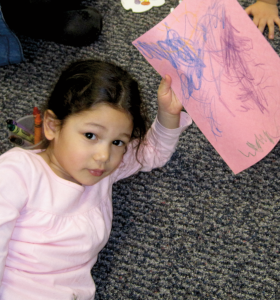
This deficit in writing competence continues
We know that achievement gaps in educational experiences exist for children of marginalized communities. These children need practice with their skills of attention and fine motor skills, as well as a better understanding of the world around them.[7] We also know that the library is the literacy center that welcomes everyone to programs like story times that feature early literacy skills. I encourage librarians who serve children and young adults to add a component of writing to their literacy programming for all ages.
Reading involves decoding symbols (words constructed of letters of the alphabet) on the page and making meaning from them, while writing is the creation of symbols to communicate meaning. More than once, a preschooler has attended one of our Writing Box programs with an older sibling. We simply provide paper taped to the linoleum floor and two or three large, water-soluble markers. The preschooler creates what we would call scribbles , and we perceive random marks. But if I ask about what is written on the page, the child can point to the symbols and tell me that story. In the reading and communication of those symbols, we see the beginnings of literacy.[8]
As part of the Public Libraries’ summer reading program, the Writing Box activity increases parent engagement, promotes family literacy, and, above all, is fun. The Writing Box program is easy to replicate, inexpensive, requires very little prep and no technology, and is relevant to all ages. The writing workshops described in this volume have all been successful in my public and school libraries.
Who are these programs for?
The structured programs are for ages 6–14. Any Writing Box program can be adapted to meet a range of ages—including early elementary (first through third grades), middle elementary (third through fifth grade), or middle school (fifth through eighth grade). (Yes, these may overlap.)
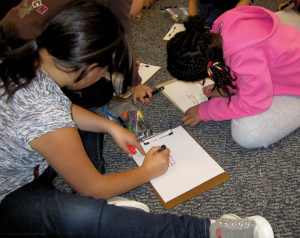
Endnotes
- Edwards, Sharon A., and Robert W. Maloy. Kids Have All the Write Stuff: Inspiring Your Children to Put Pencil* to Paper : *or Crayon, or Felt-tip Marker, or Computer. New York, N.Y.: Penguin, 1992. Print. ↵
- Frederick, Heather Vogel. “‘Writing Box’ Helps Kids Enjoy Writing, Aids Reading. (Sharon Edwards’, Robert Maloy’s Hands-on Tools).” The Christian Science Monitor, 14 Dec. 1992: 12. Web. ↵
- Dillon, Sam. “Asbestos in the Schools; Disorder on Day 1 in New York Schools.” The New York Times, 21 Sept. 1993. ↵
- Roman, Susan, and Carole D. Fiore. “Do public library summer reading programs close the achievement gap?” Children and Libraries 8, no. 3 (2010): 27-31. ↵
- Heather Michele Moorefield-Lang , (2014),”Makers in the library: case studies of 3D printers and maker spaces in library settings,” Library Hi Tech, Vol. 32 Iss 4 pp. 583-593. ↵
- Paquette, Kelli R. “Encouraging Primary Students’ Writing through Children’s Literature.” Early Childhood Education Journal 35, no. 2 (2007): 155-65. ↵
- Grissmer, David, Grimm, Kevin J., Aiyer, Sophie M., Murrah, William M., & Steele, Joel S. (2010). Fine Motor Skills and Early Comprehension of the World: Two New School Readiness Indicators. Developmental Psychology, 46(5), 1008-1017. ↵
- Beginnings of Literacy, Joan Brooks McLane and Gillian Dowley McNamee, Erikson Institute, Zero to Three Journal, September 1991. z.umn.edu/wbr1 ↵

